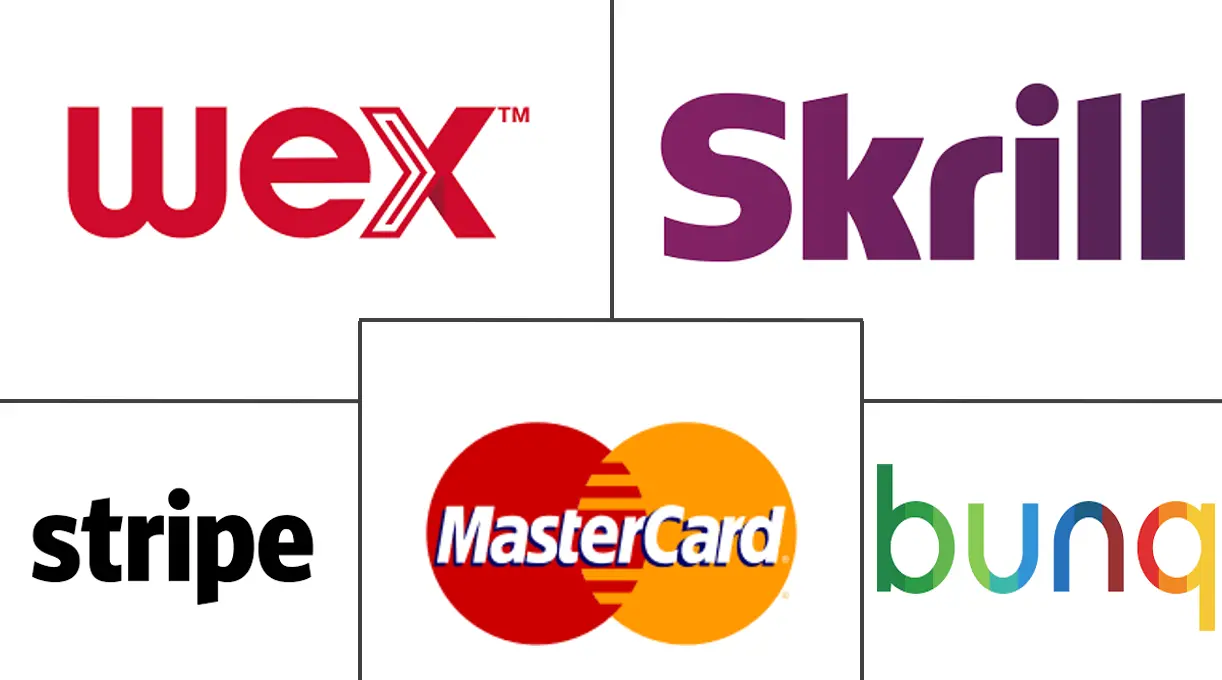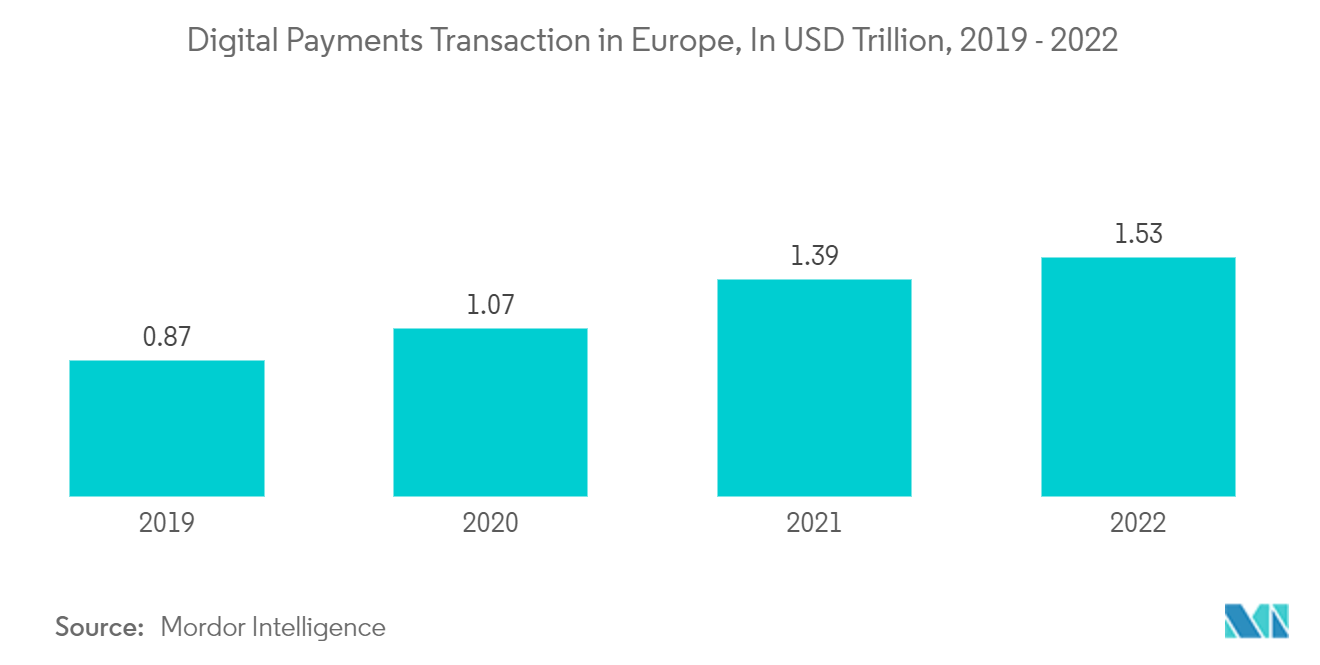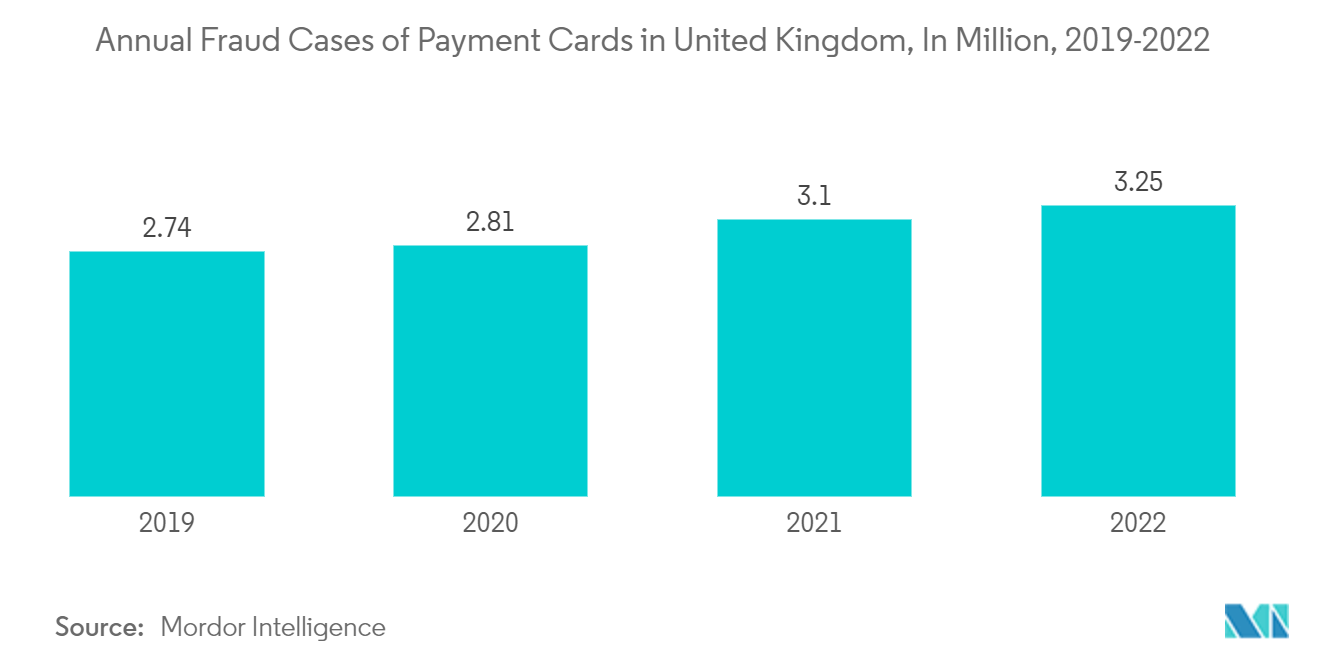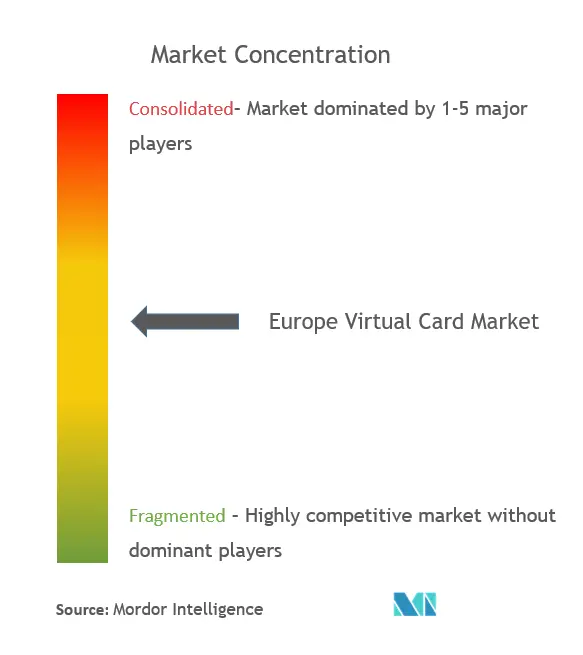Europe Virtual Cards Market Analysis
The Europe Virtual Cards Market size is estimated at USD 62.21 billion in 2025, and is expected to reach USD 154.79 billion by 2030, at a CAGR of 20% during the forecast period (2025-2030).
The value of Digital transactions has observed a continuous increase over the years rising to more than USD 1.5 Trillion last year and with this increasing amount of digital transaction risk of cyber fraud has also observed a continuous increase in Europe. As a solution to this banks have come up with virtual cards through which a user can make a certain amount of transaction at a time. A specific virtual card can be produced for each transaction with a unique Card number, and credential which differentiate it from the original card the user is holding.
Denmark, Sweden, and the United Kingdom are among the countries in Europe leading in instant payment methods and provide opportunities for banks and financial institutions to expand virtual card payment systems which reduces the level of risk in digital transaction and increase the adoption of transaction-specific virtual cards. With the rising trend of digital payments, Europe's debit card base is observing a y-o-y growth of around 5.5% with a penetration of 1.31 debit cards per capita. This trend is expected to drive the market of virtual cards in the region as an orginal debit card is a precondition condition for having a virtual debit card issued by the bank.
Post Covid, as global businesses are recovering combined with an increase in cyber attacks virtual cards are providing merchants with a more secure way of doing transactions. Instead of using physical cards or checks, virtual cards offer high transaction volume that can be created and used instantly by businesses. With rising e-commerce in Europe, players such as Alibaba, Amazon, and Apple, others have started accepting virtual debit or credit cards, increasing the number of virtual cards issued by the banks. These trends combined with a rising digital payment industry in Europe are creating opportunities for the expansion of Virtual cards in the region.
Europe Virtual Cards Market Trends
Rising Digital Payment
The digital transaction payments volume in Europe is observing a continuous growth of more than 16% annually with an increasing number of people using Net Banking, UPI, and other emerging payment methods. Post-pandemic almost (2/3) of the consumers in Europe had started using contactless payment more often in comparison to the pre-pandemic level. Cashless payments are becoming an appealing alternative to many European consumers resulting in a significant impact on the payments industry which was traditionally dominated by cash and cheques. The United Kingdom has emerged as the largest e-commerce market in the region with more than half of the transactions being made digitally resulting in an increasing number of E-commerce platforms accepting virtual card payment methods. Along with these trends, with card payment existing as a leading cashless payment method in the region, it is expected to drive the virtual card market over the coming period in the region.
Rising Cyber Attacks & Payment Scams
A unique card detail associated with each transaction made through virtual cards is a development towards cyber risk-related security in digital payment methods. The value of e-commerce losses to online payment fraud in Europe has observed a continuous rise over the years leading to each virtual card being limited with a fixed amount of transaction limit and post transaction or after the expiry date whichever is earlier the card loses its value. Virtual cards exist with a shorter period of expiry date in comparison to regular debit cards and post expiry, the money is returned to the user account resulting in virtual cards emerging as an efficient payment method for businesses who need to deal with multiple transactions at a given point of time. The United Kingdom, Ireland, Denmark, and France exist as the European countries with the largest value of fraud in digital payments and the availability of virtual cards is helping people in the region to reduce these online digital payment risks.
Europe Virtual Cards Industry Overview
The European virtual card market is partially fragmented with an increase in the number of players offering and accepting virtual cards as the volume of digital transactions in the country is observing an increase. Technological advancement and service innovation are resulting in an increased partnership among domestic and international players for expanding virtual cards in the region. Some of the existing players in the European virtual card market are Skrill, Mastercard, Qonto, and Stripe.
Europe Virtual Cards Market Leaders
-
WEX Inc
-
Skrill
-
Master card Inc
-
Stripe
-
Bunq
- *Disclaimer: Major Players sorted in no particular order
Europe Virtual Cards Market News
- In September 2023, Lloyds Bank launched a new virtual card for its businesses in partnership with Visa. The virtual card payment service will be available to Lloyds customers and is designed for users to control and track spending with the simplification of the payment process. Visa Commercial Pay exists as a virtual payment solution providing the technology to help businesses simplify and streamline their payments in a secure and controlled way.
- In September 2023, Wallester which operates in virtual card solutions partnered with Transferra which exists as a fintech provider in Europe. The partnership will be expanding Wallester's virtual card business in the European region and make its transactions more secure.
Europe Virtual Cards Industry Segmentation
A virtual card is a digital card and has features similar to physical bank cards, it is stored in a digital wallet on a phone and can be used to pay contactless in stores or online. It is secured by encryption and has its own unique card number, expiry date, and cvc.
The European virtual cards market is segmented by product type, by end-user, and by country. By product type, the market is segmented into b2b virtual cards, b2c remote payments virtual cards, and b2c poc virtual cards. By end-user, the market is segmented into consumer use and business use. By country, the market is segmented into the United Kingdom, Germany, Switzerland, France, Italy, Spain, and the rest of Europe. The report offers market sizes and forecasts for the European virtual card market in value (USD) for all the above segments.
| By Product type | B2B Virtual cards |
| B2C Remote Payments Virtual Cards | |
| B2C POC Virtual Cards | |
| By End-user | Consumer use |
| Business use | |
| By Country | United Kingdom |
| Germany | |
| Switzerland | |
| France | |
| Italy | |
| Spain | |
| Rest of Europe |
Europe Virtual Cards Market Research FAQs
How big is the Europe Virtual Cards Market?
The Europe Virtual Cards Market size is expected to reach USD 62.21 billion in 2025 and grow at a CAGR of 20% to reach USD 154.79 billion by 2030.
What is the current Europe Virtual Cards Market size?
In 2025, the Europe Virtual Cards Market size is expected to reach USD 62.21 billion.
Who are the key players in Europe Virtual Cards Market?
WEX Inc, Skrill, Master card Inc, Stripe and Bunq are the major companies operating in the Europe Virtual Cards Market.
What years does this Europe Virtual Cards Market cover, and what was the market size in 2024?
In 2024, the Europe Virtual Cards Market size was estimated at USD 49.77 billion. The report covers the Europe Virtual Cards Market historical market size for years: 2020, 2021, 2022, 2023 and 2024. The report also forecasts the Europe Virtual Cards Market size for years: 2025, 2026, 2027, 2028, 2029 and 2030.
Our Best Selling Reports
Europe Virtual Cards Industry Report
Statistics for the 2025 Europe Virtual Cards market share, size and revenue growth rate, created by Mordor Intelligence™ Industry Reports. Europe Virtual Cards analysis includes a market forecast outlook for 2025 to 2030 and historical overview. Get a sample of this industry analysis as a free report PDF download.







